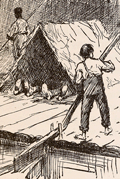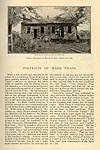
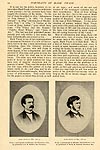
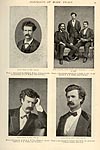
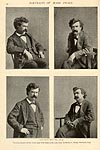
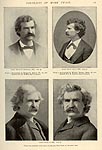
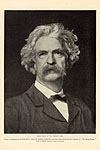
| [McClure's Magazine was published in New York. Ten years after this sheaf of photographs appeared, Willa Cather became one of its editors. There's no indication who wrote or assembled this article. Not all the captions are reliable, and there are also anomalies in the text (which uses, for example, the British title for A Connecticut Yankee in King Arthur's Court), but the collective image it offers of MT is representative of the way many Americans saw him at this time: a success in spite of his bankruptcy.] |

|

|

|

|

|

|
|
|
|||||
|
Text of the article: WHEN a few months ago, because of the failure of a publishing house in which he was a partner, Samuel L. Clemens ("Mark Twain") set out to traverse the whole width of America and the Pacific Ocean, into Australia, on a two years' lecturing tour, it was generally remarked as a hard necessity--at his time of life. He had turned, or was just turning, sixty; and while sixty, for men of fair physical endowment, is by no means old, it is still an age at which most men would more than shrink from such an enterprise. To Mark Twain, however, it probably seemed no very considerable matter, for he has been a wide journeyer all his life. While born at Florida, Missouri (November 30, 1835), he was reared at Hannibal, Missouri, on the banks of the Mississippi; at thirteen he became apprenticed to a printer, and during the next few years, in pursuit of his craft, he wandered to St. Louis, Cincinnati, Philadelphia, and even New York. Then he became a pilot on the Mississippi River. Thus much going to and fro Mark Twain had accomplished while yet a youth. In 1861 he went to Nevada; a few years later to California, and finally to the Sandwich Islands. First he served as clerk to his brother, the Secretary of the Territory of Nevada; then he was a newspaper reporter and editor; he ventured unsuccessfully in mining, and not unsuccessfully in lecturing. From the Sandwich Islands he began to work eastward again, and in 1867 he reached New York, and published his first book, "The Jumping Frog and Other Sketches," and then set out on that tour of Europe which yielded the material for "Innocents Abroad." "Innocents Abroad" was published in 1869, and since then Mark Twain's humor has been a wine that needed no bush. In three years the book sold to the number of one hundred and twenty-five thousand copies. Mark Twain is sometimes reputed to be a reluctant worker; he at least has not been an eager publisher. Even the success of "Innocents Abroad" did not tempt him to press again for several years. Then he put forth "Roughing It," and a year later, in conjunction with Charles Dudley Warner, "The Gilded Age." By this time he had married, and "settled down" at Hartford, Connecticut. But the settling down was nominal merely. He became a professional lecturer, and travelled widely winter after winter. Then he went often to Europe, making long sojourns there. Consequently, setting off at sixty on a lecturing tour to Australia, was for him little more than a resumption of the habit of a life. It is not for the public, however, to repine when Mark Twain is forced to undertake a new journey; for his journeys have been largely the occasion of his books. To the list of these he added, in 1876, "Adventures of Tom Sawyer"; in 1880, "A Tramp Abroad"; in 1884, "Adventures of Huckleberry Finn"; in 1889, "A Yankee at the Court of King Arthur"; since which have come "The Prince and the Pauper," "Pudd'n Head Wilson," and "Joan of Arc." The last was first published anonymously, and only within a few weeks has been authentically announced as his. Mark Twain is one of two representatives in permanent literature of a now all but extinct, but in its day a most picturesque and interesting, class--the itinerant printers. The "tramp" printer, who still exists in some degree, is but a degenerate and rude survival of this class, and gives no true impression of what the class was in its best estate. The older race, with whom it was a point of honor to abide nowhere for long, were men of singular cleverness and ingenuity of mind. They read the matter they put into type, which the printer of to-day seems rarely to do; and thus, and by observation on their wide travels, they became a race of philosophers. They could write for the papers on which they served, as well as set type; and much of the wit and wisdom of the newspaper columns was of their contribution. Most of their writing was for the day; but in the case of Mark Twain it developed, by slow degrees, to the quality of literature. And it did the same in the case of Walt Whitman. To the strict vocation of printer, indeed, Mark Twain gave only a few years, and these of his youth; but his way of life, and his attitude toward life have ever remained in spirit those of the old roving fraternity of the "stick." Men of information and ideas, these old printers were; but, of course, they were in no sense men of the study. And herein, again, Mark Twain is of their kind. He is a man of literary cultivation, and even, it is said, in some measure a scholar; and, in writing his books, he sweats at his desk, and pulls his hair, after the fashion of the strict man-of-letters. But for all that he is a man who lives and experiences, rather than one who conceives and records; and all accounts agree that he is even better entertainment in private life than on the platform or in his books. Either where, however, he is so good--so free and gracious and wholesome--that one may hope he will live until the series of his portraits has become twice as long as the by no means meagre one presented here. |

